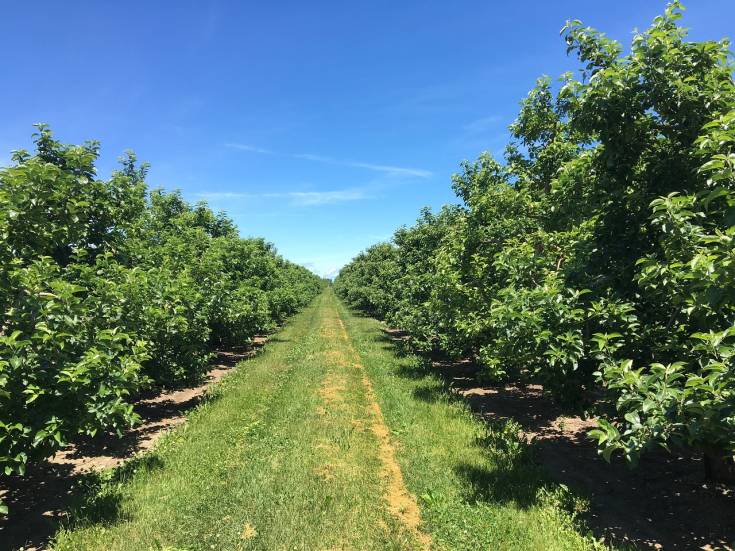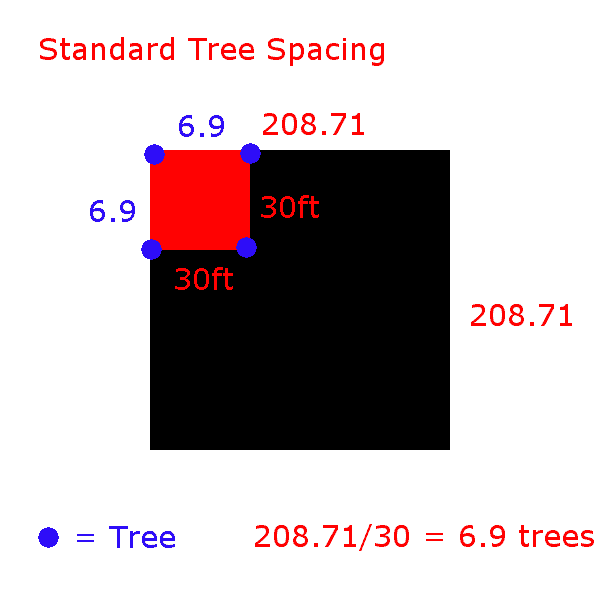Who doesn’t like a juicy red apple every once in a while? I grew up taking an apple to school every day – yes, I was that kid with the apple in his lunch box.
It wasn’t a problem because, unlike some of my classmates, I actually liked fruit in general (with apples being a particular favorite).
With that in mind, I like the idea of an apple orchard right outside my window. Now, here’s the question you may have if you want to plant your own orchard:
How many apple trees can be planted per acre of land?
An average orchard can have around 36 standard-sized apple trees per acre. If you have semi-dwarf trees, you can fit 170 per acre, while up to 400 dwarf apple trees can fit in the same space.

An Expensive Venture
As a general rule: it takes around $10,000 per acre for the first two years or so to start a high-density apple orchard. It takes several years to make an orchard profitable, and that makes it crucial that you know exactly what trees will do well on your land.
That’s where growing an apple orchard becomes complicated – there are over 8,000 different species of apple trees; how do you know which is the right one for you?
Apple trees are generally adaptive to their climate, but certain climates are preferred by certain species. Some can handle extreme cold, while others prefer warmer, coastal climates.
In general, however, most apple tree species require around 500 to 1000 hours of cold weather to bring us a crisp, tasty fruit…I almost feel bad for them.
Most Common Types of Apples to Plant
Most apple trees that we have today are hybrids of two trees native to Asia: Malus Pumila and Malus sylvestris – note: Malus is the species’ scientific name. The four cultivars of apples that I’m most familiar with are:
- Red Delicious
- Fuji
- Golden Delicious
- Granny Smith
Before you ask, yes, those are the actual names of these apples. Each one has slightly different requirements for planting.
The Red Delicious tree requires a depth of 2 to 3 feet, and a distance of 12 to 15 feet between each tree (10 feet for the smaller, dwarf variety). They also require six hours of unfiltered, direct sunlight.
The red, delicious apple has a mild sweetness to it, which makes it very good for desserts.
Fuji apples are one of the better-known apples available in stores nowadays. They’re known for being super sweet with a crisp texture and flavor. As far as looks go, Fuji apples have a greenish skin with red highlights.
These are a Japanese hybrid of the red delicious and Virginia genet. In terms of spacing, these trees grow between 15 and 20 feet wide in a spread of between 4.5 – 6.1 meters and require between 200 and 400 hours of chill time.
Golden Delicious apples have a sweet flavor to them that’s great in pies, salads, and certain meat dishes. They’re self-pollinating and can be found in sizes of 8 to 10 feet (for the dwarf variety) and 12 to 15 feet (semi-dwarf).
They’re easy to grow and don’t actually take up much space at all. As far as weather requirements, they need to be in full sun and can tolerate high temperatures – both hot and cold.
Granny Smith apples are a very familiar sight in grocery stores. They’re known for their lime-green color, crisp texture, and flavor.
These apples are insanely popular and can be used in pies/desserts, ciders, or in cooking. The flavor has a sweet but has a certain tartness to it which gives it a nice sharp taste.
How Much Space do Apple Trees Need?
As far as the number of trees to plant per acre, an average orchard has around 150 – 180 trees per acre. A higher-density orchard would have 450 – 600 trees.
With that said how much space per acre do apple trees need? Well, that depends on what size trees you’re planting.
Standard, semi-dwarf, and dwarf trees all require specific amounts of space; which means it’s time for a quick math lesson! Oh, you’ll need a calculator unless you can do this in your head.
Standard-sized trees are the largest of the three sizes, and they require between 30 – 35 feet (9 – 11 meters) of space between each tree. The semi-dwarf, medium-sized trees require 15 feet (5 meters) between each tree. Dwarf trees need 10 feet (3 meters).
With that in mind, I worked out that you could plant 25 – 36 standard-sized trees on a 1-acre plot. You can plant around 169 semi-dwarf trees and around 400 dwarf trees on a 1-acre lot.
The Math:
1 acre = 43,560 square feet (208.71 ft. x 208.71 ft.) – this is 4,047 square meters.
1 standard tree needs 30 – 35 feet of space.
Start by getting the square root of 43,560 (208.71).
Divide by 30, and you get 6.9 trees.

BUT: you can’t have 0.9 of a tree – it’s not physically possible. So, we treat the 0.9 as extra space. This gives us six rows of six trees: 6 x 6 = 36.
Therefore you have 36 standard-sized trees.
If you worked with a spacing of 35 ft, you’d get 5.9; you do the same thing. The 0.9 is treated as extra space, 5 x 5 = 25. So, you can plant between 25 and 36 trees on one acre of land.
Semi-dwarf trees would be: 208.71 / 15 = 13.9
13 x 13 = 169 semi-dwarf trees
Dwarf trees would be: 208.71 / 10 = 20.9
20 x 20 = 400 dwarf trees
Okay, math lesson over; if you did that in your head, good for you!
How Many Apples Can An Acre Produce?
The answer depends on a number of factors, including the type of apple tree, the climate, and the amount of care it receives.
A typical apple tree can bear fruit for up to 20 years, and it takes about 7-8 years for a tree to mature enough to produce a full crop. In a single season, an acre of apple trees can yield anywhere from 700 to 8,000 apples.
However, the average yield is closer to 3,000 apples per acre. So, if you’re looking to grow your own apples, you can expect a healthy harvest from just a few trees.
How Many Apple Trees Do You Need to Make a Profit?
If you’re thinking about planting an apple tree or two for profit, you’ll need to do your research to find out how many trees you’ll need to plant. Several factors will affect your profitability, including the type of apples you plan to grow, the climate in your area, and the size of your harvest.
Generally speaking, however, you’ll need to plant at least a few hundred trees to make a significant profit.
Of course, the number of trees you’ll need to plant will also depend on how much money you want to make.
If you’re just looking to cover the cost of your investment, you won’t need to plant as many trees as someone who’s hoping to make a real profit. But regardless of your goals, remember that it takes time and effort to grow a healthy apple crop. By doing your homework now, you can set yourself up for success in the future.
What Apple Varieties Produce the Highest Yield?
Some cultivars are better suited for fresh eating, while others are better for cooking or cider making. But when it comes to yield, some cultivars definitely stand out.
One apple variety that is known for its high yield is the cultivar Hauer Pippin. This cultivar was developed in Germany in the early 1800s and is now grown commercially in many apple-producing countries. ‘Hauer Pippin’ trees are relatively small, but they produce a large number of fruits that are typically around 2 inches in diameter.
Another high-yielding cultivar is ‘Freyberg’, which was developed in New Zealand in the 1940s. This cultivar is a cross between ‘Granny Smith’ and ‘Golden Delicious’ and produces large, crisp apples with greenish-yellow skin. If you’re looking for an apple cultivar that will give you a high yield, ‘Hauer Pippin’ or ‘Freyberg’ are great choices.
How to Plant High-Density Orchards
Historically, apple orchards were planted using a wide spacing between trees that allowed for comfortable picking and thinning operations. In recent years, however, there has been a shift towards planting high-density apple orchards.
This type of orchard is planted with trees that are spaced much closer together, which allows for higher yields per acre. While the initial investment in planting a high-density orchard may be higher, the increased yield can more than make up for this cost over time.
In addition, the closer spacing of trees makes it easier to control pests and diseases, and it can also reduce the overall costs of pruning and thinning.
For all these reasons, high-density apple orchards are becoming an increasingly popular option for growers.
There are a few things to keep in mind when planting a high-density apple orchard.
First, it is important to choose a site that has well-drained soil and good sunlight exposure. Second, you will need to select dwarf or semi-dwarf varieties of apple trees that are suitable for close spacing.
Finally, it is important to plant the trees at the correct density; too close together and they will compete for resources, too far apart and you will not achieve the desired yield increases.
With careful planning and execution, planting an apple orchard with a high tree density can be a great way to boost your yields and improve your bottom line.
Are Orchards a Lot of Work?
Apples are a great option for a backyard orchard – and once you get started with them, you could expand to growing things like figs, lemons, pear trees, apricots, peaches, plums, cherry trees, and more.
Ultimately, maintaining an orchard can be a lot of work, but it can also be a rewarding experience.
Pruning, grafting, and thinning trees are just a few of the tasks that are necessary to produce high-quality fruit. In addition, orchards need to be carefully monitored for pests and diseases.
However, they can also provide a beautiful setting for family gatherings and picnics. They can also be a source of fresh, locally-grown fruit. For those who are willing to put in the effort, an apple orchard can be a wonderful addition to their homestead.
In closing, I hope you found this article informative and enjoyable to read. Now that you know how many trees to plant, I wish you all success in your apple-growing venture.

Greg spent most of his childhood in camping grounds and on hiking trails. While he lives in the suburbs nowadays, Greg was raised on a small farm with chickens. He’s a decent shot with a bow, and a huge knife enthusiast. Find out more about Greg.

Love and appreciate this article. We plan on planting an acre of apples trees.
I’m looking at my brothers 10 acres in Franklin, Tenn. plus some peach trees and pears if applicable. I’m located in California and worked in produce industries. Plus worked on a 120 acre fruit ranch in Northern California.